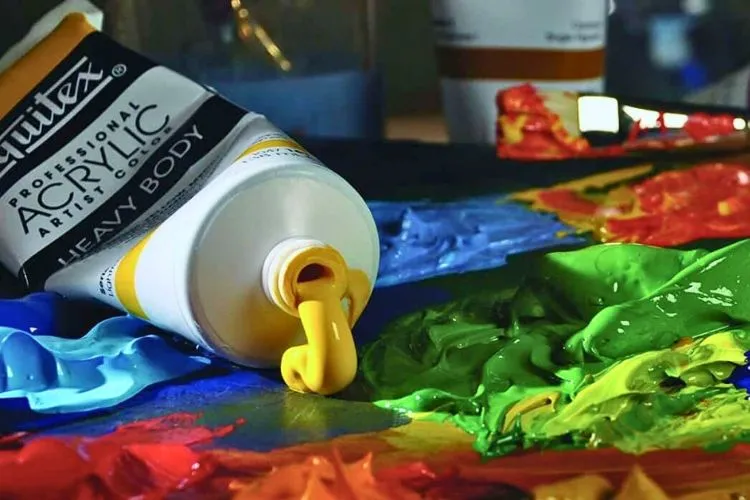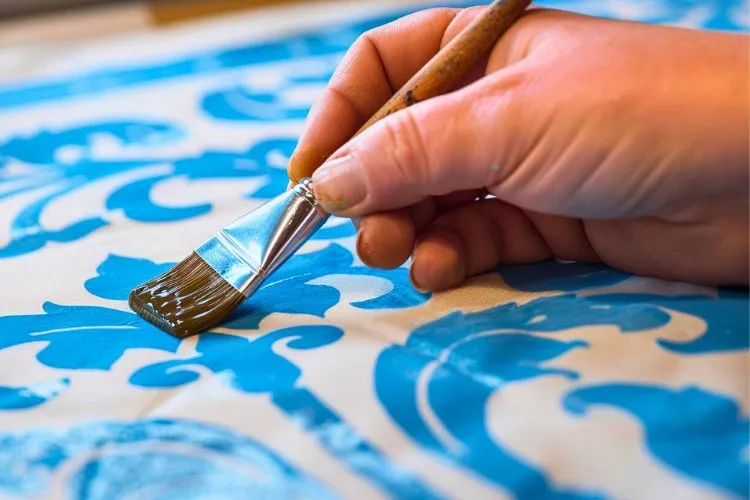When diving into textile and fabric arts, the choice of paint can significantly affect the outcome of your project. Fabric paint and acrylic paint are popular options, each offering unique features and benefits.
This guide aims to explore the fabric paint Vs acrylic paint differences, uses, and tips for working with these paints, providing a clear understanding for artists and hobbyists alike.

Understanding Fabric Paint
Definition and Composition
Fabric paint is specifically designed for use on textiles, embedding itself into the fibers to provide a durable and flexible finish. Its formulation allows it to withstand washing and wear while maintaining color vibrancy.
Key Characteristics
The unique property of fabric paint is its flexibility and washability. Unlike other paints, it does not crack or peel off when applied to a flexible surface like fabric. This makes it ideal for wearable art and upholstered items that require regular cleaning.

Pros and Cons
The main advantage of fabric paint is its compatibility with textiles, ensuring the paint adheres well and remains colorfast after washing. However, a limitation is its color range, which may not be as broad as that of acrylic paints.
Best Uses for Fabric Paint
Fabric paint shines when used on clothing, bags, and furniture coverings. It is perfect for projects that demand a soft, flexible finish without altering the texture of the fabric significantly.
Understanding Acrylic Paint
Definition and Composition
Acrylic paint is a versatile, water-based paint known for its fast drying time and vibrant color selection. Its adaptability across different surfaces makes it a favorite among artists.
Key Characteristics
Acrylics offer a wide spectrum of colors and can be diluted with water or modified with mediums to achieve various textures and finishes.
Although primarily used on canvas, they have been adapted for fabric through the addition of a textile medium.

Pros and Cons
A significant benefit of acrylic paint is its versatility and ease of mixing, which allows for endless color possibilities. However, when used on fabric without modification, it can result in a stiff and prone-to-cracking finish.
Transforming Acrylic Paint for Fabric Use
By incorporating a textile medium into acrylic paint, it becomes more flexible and adherent to fabric, making it an adaptable choice for textile art.
Fabric Paint Vs Acrylic Paint
Performance on Fabric
Fabric paint offers better washability and durability, which is crucial for wearable items. Acrylic paint, when modified, can perform similarly but may not withstand heavy wear or frequent washing as well.
Application Techniques
Both paints are versatile in application, compatible with brushes, sponges, and stamps. Fabric paint, however, requires less preparation when applying directly onto textiles.
Finish and Feel on Fabric
Fabric paint tends to maintain the fabric’s natural feel, whereas acrylic can stiffen the fabric unless properly diluted or modified.
Availability and Cost
While both paints are widely available, fabric paint is typically more specialized and may come at a higher price point. Acrylic paint offers more budget-friendly options and a broader selection.
You may also read: Acrylic vs Latex Paint
Application Tips for Each Paint Type
Fabric Paint
For optimal results, pre-wash the fabric to remove any sizing or oils that could hinder paint adherence.
Applying fabric paint in thin layers allows for better drying and less stiffening of the fabric. Setting the paint, often by ironing, ensures durability and washability.

Acrylic Paint with Textile Medium
When using acrylic paint on fabric, mixing it with a textile medium is essential. This mix not only thins the paint, making it more suitable for fabric application but also enhances its flexibility and washability. Heat setting after application is also advised to ensure longevity.
Health and Safety Considerations
Toxicity and Environment
The safety of using fabric and acrylic paints is paramount, especially considering potential skin contact and inhalation hazards. Fabric paints are generally safe for use on wearable items and come with minimal toxic risks when used according to instructions.

Acrylics, while also safe for general use, can contain more volatile organic compounds (VOCs), particularly in professional grades, which may affect air quality and pose a greater risk if ingested or inhaled over long periods.
Regarding environmental impact, disposal of unused paint and cleaning solvents must be considered, as they can harm waterways and wildlife.
Precautions and Best Practices
To ensure the safety of both the artist and the environment, it’s crucial to work in a well-ventilated area to minimize inhalation risks.
Wearing protective gear, such as gloves and masks, can provide an additional safety layer, particularly when dealing with aerosol fabric paints or when sanding dried acrylics.
Always follow the specific disposal instructions on paint containers, and consider using eco-friendly or water-based paints to lessen environmental impact.
When cleaning brushes or equipment, do so in a way that minimizes the release of harmful chemicals into the drainage system. By adhering to these precautions, artists can enjoy a safe and sustainable painting experience.
Frequently Asked Questions (FAQs)
Can acrylic paint be made washable for fabrics?
Yes, by using a textile medium with acrylic paint, it becomes more flexible and washable, making it suitable for fabric applications.
Will fabric paint crack after multiple washes?
No, fabric paint is designed to embed into the fabric fibers, maintaining its integrity and color vibrancy even after multiple washes.
How can I ensure fabric paint stays on after laundering?
Setting the paint properly, usually by ironing over the painted area, helps lock the paint into the fabric, ensuring it remains intact through wash cycles.
Is it necessary to heat set fabric painted items?
Yes, heat setting is crucial for both fabric and acrylic paints (when modified) on textiles. It helps secure the paint onto the fabric, extending the life of the painted design.
Can I use acrylic paint on any type of fabric?
While acrylic paint can be used on various fabrics, results can vary depending on the fabric’s weave and composition. Testing on a small area is recommended to ensure compatibility.
Conclusion:
Choosing between fabric paint and acrylic paint for your textile project depends on the project’s nature, the desired finish, and durability requirements.
Fabric paint is ideal for wearable arts that need to withstand regular washing, while acrylic paint, with a textile medium, offers a broader color palette and is versatile across multiple surfaces. Regardless of choice, proper application and heat setting are key to achieving professional, long-lasting results.
This guide provides the necessary insights into selecting and using fabric and acrylic paints, helping you embark confidently on your fabric painting journey.

Meet Isabella Anderson, your acrylic painting mentor with over a decade of brush-wielding mastery. Dive into the colorful world of acrylics with her expert guidance, featured exclusively on ‘Acrylic Authority.’ Unleash your inner artist and explore the limitless possibilities of this versatile medium alongside a true acrylic aficionado.
